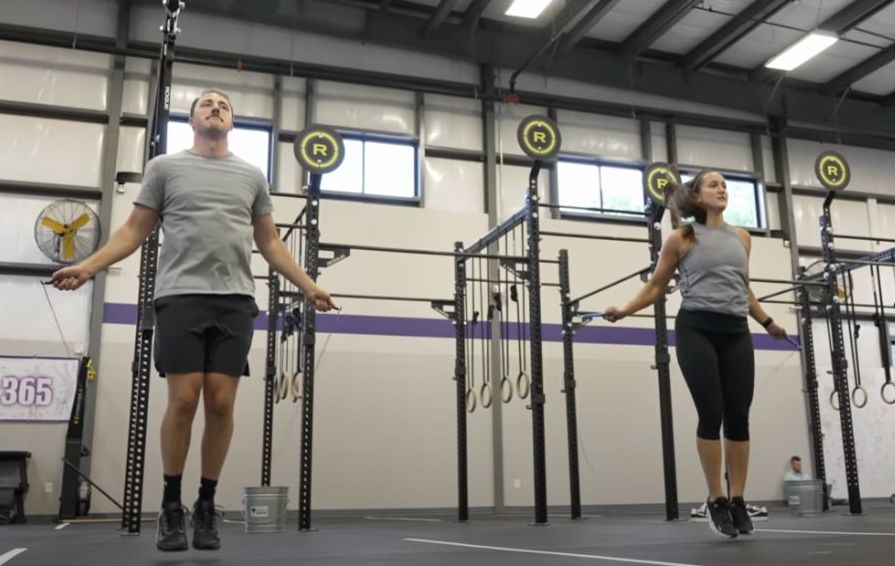We test and review fitness products based on an independent, multi-point methodology. If you use our links to purchase something, we may earn a commission. Read our disclosures.
Don’t think you have time for cardio with all the cable curls and dumbbell curls you need to do, brah? If you want things in life other than big pipes, like a useful aerobic base and a functioning cardiopulmonary system, you’ve got to get your heart rate up with a good cardio workout.
Jumping rope is an efficient and low-tech workout you can squeeze into a busy schedule with minimal investments of money and time. Learning how to jump rope, the types of jump ropes available, and simple and effective programming for jump rope training can be an asset to just about anyone’s routine.
We consulted with Amanda Capritto, a certified personal trainer and self-proclaimed lover of double-unders, for her expert advice on how to master the jump rope.
1. Choose the Correct Rope
Maybe you want to just take an old extension cord and whip it around instead of finding the proper rope? If you aren’t into self-flagellation, do yourself a favor and get a proper jump rope.
One size doesn’t fit all (except for moo-moos and neckties). The same goes for picking the type of jump rope you need.
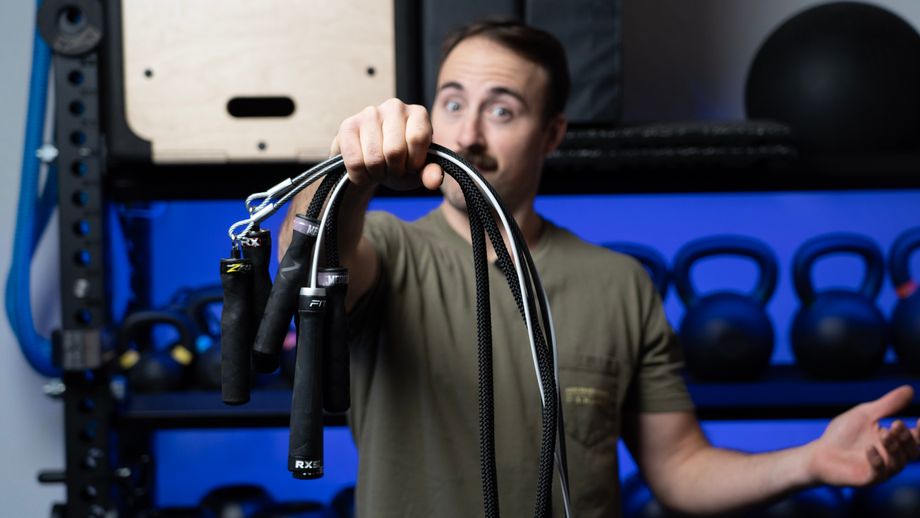
The main concern here is the weight of the rope. Going too light can make it difficult to feel the middle of the rope as it moves around your head. Beginners benefit from really feeling the centripetal force created by the arc of the rope. Ropes that have beaded cords audibly slap the ground and help keep the momentum of the parabola.
Beginners can also use the assistance from weighted jump ropes, like the beaded variety, to develop their jump rope skills early and ingrain proper form without the frustration or embarrassment of constantly hitting their shins with a whippy rope.
On the other end of the spectrum, advanced jumpers who want to maximize speed or show off fancy jump rope tricks like double-unders and triple-unders will want a lighter rope, like a speed jump rope.
2. Find the Right Rope Length
Finding the right length jump rope may be the most important step when making a purchase.
“Success in jumping rope starts with the rope,” Amanda says. “Buy the right size! Most jump ropes come in a few different sizes to accommodate people of different heights. Make sure to check the size chart and select the one that corresponds to your height.”
Working with a too-short rope and dragging your knuckles on the ground may have an appeal to the ultra-paleo crowd, but the rest of us need the jump rope length to match our height to avoid the posture of homo erectus.

“If you buy a cut-and-size rope, make sure you have a good pair of wire cutters on hand,” Amanda warns, as many wire ropes can’t be cut with regular scissors. This will make a big difference in your ability to perform consistent reps.
To size your rope correctly, stand with both feet on the rope and pull the rope taut. The handles, pointed upward, should fall between your collarbone and chin, with the end of the rope hitting close to your armpit height.
3. Hold the Rope Correctly
It sounds simple, and it is. Grab the handles with a relaxed grip toward the end of the handles, not toward where the rope meets the handle.
Hold your hands by your sides with the jump rope behind your feet.
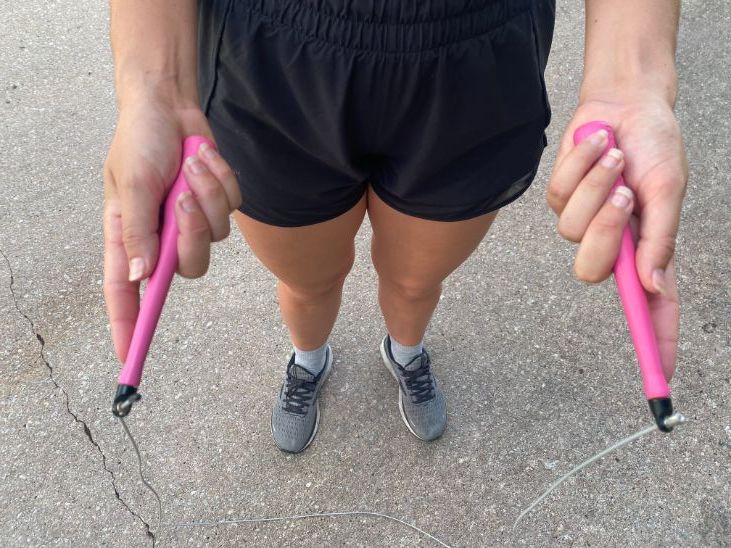
Amanda notes, “Keep your elbows in. Don’t flare your elbows out while rotating the rope. Most of the movement should come from your wrists, not your elbows or shoulders.”
I know your pipes are strong, and you cut the sleeves off all your medium shirts, but leave them out of it for now. Keep your arms down by your sides and your wrists loose as you turn the rope.
4. Use Proper Jumping Form
A basic jump comes from the ankles with only a very slight bend in the knees. Keeping the knees bent means the jump produces less impact on the lower body, making it more suitable for beginners. In other words, it will have a positive impact on the body’s ability to absorb force.
Your body weight moves no more than 1 to 2 inches off the ground; just enough for the jump rope to pass gracefully under your feet.
“It’s a cute lil hop and not a donkey kick,” says Amanda.
Keep your knees slightly bent on the way up and down, but don’t bring them up like a frog hop. Think ankles and calves, with knees and quads as pillows to help land.
The secret to jumping rope and comedy is the same: timing.
Amanda also says you can work on getting the feel of the rope down before moving into the basic jump phase: “You can practice the arm movement by stepping over the rope, instead of jumping over it, for your first few reps. As the rope passes overhead, prepare for a jump by slightly bending your knees.”
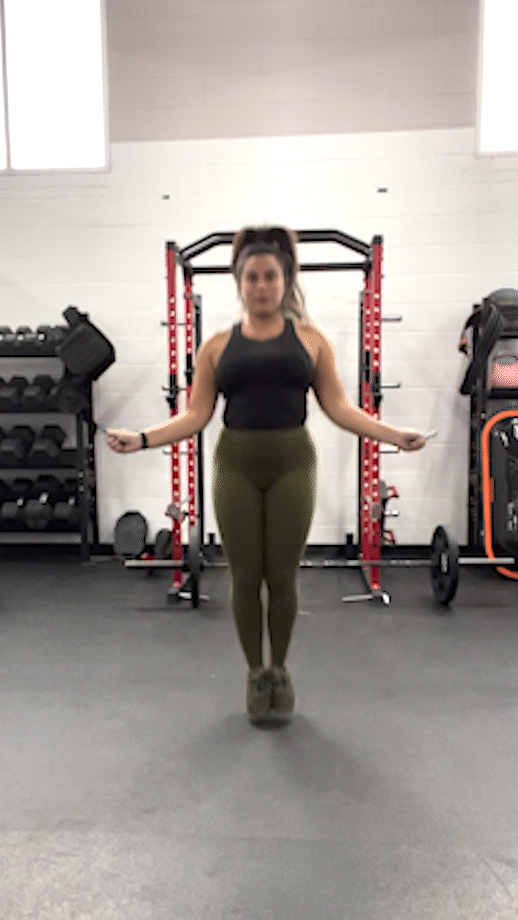
5. Practice
You might feel silly at first, but remember you can jump rope anywhere. If you are self-conscious, get out of the gym and hide anywhere with a 4-foot-by-4-foot section of free space.
Keep in mind that you will get frustrated, but remind yourself this is a new skill, not just an aerobic workout. You will be able to push into more high-intensity ranges as your technique—a totally separate entity than your cardio level—advances.
If you are still struggling, put the rope down and set a metronome (or click-track for anyone below 50) to 90 beats per minute and do little bounds to the beat. Work in some “air jump rope” and start twirling your wrists to work on coordination. Rub your stomach and pat your head while reciting Oh Captain My Captain (kidding). You should feel better with the rhythm of the action as you go on.
Beginner Jump Rope Workout
Start small!
This a simple beginner jump rope workout with built-in progressions. This is ideal for someone new to jump rope exercises or someone who needs to build aerobic capacity up from a low base. It starts:
10 rounds
:30 jump rope
1:00 rest
How to Do It:
Spend 30 seconds practicing jumping rope, followed by 1 minute of rest.
This may start with simply taking the rope from behind your feet to in front of your feet, stepping over the rope, and repeating. Or, you may be able to string multiple jumps in a row. Wherever your fitness level is, the intention is to work for 30 seconds and rest double that time so you are recovered and can hit the next interval “fresh.”
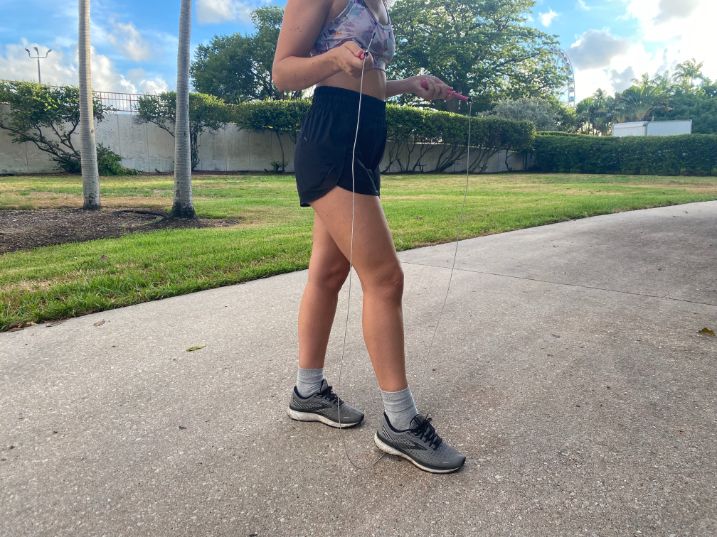
During the workout, I like to look at an old fashioned analog clock. You can choose not to be a luddite and download a circuit timer for your phone if you prefer. As you improve, you can progress by increasing your work and decreasing your rest, like so:
10 rounds:
:45 jump rope
1:00 rest
Other ways to progress these workouts:
- Add more rounds
- Do it with double-unders
- Plank instead of resting
- Wear a weight vest
Based on how you feel, you can practice jumping rope almost every day. Eventually, you should feel comfortable skipping rope for 10 minutes straight without rest. The progression is slow enough you might not even notice it until you look back and see how much more you can do than before.
Full-Body Jump Rope Workout
Below is a sample full-body workout involving a jump rope. You get to pull, push, squat, hinge, and plyo-hop:
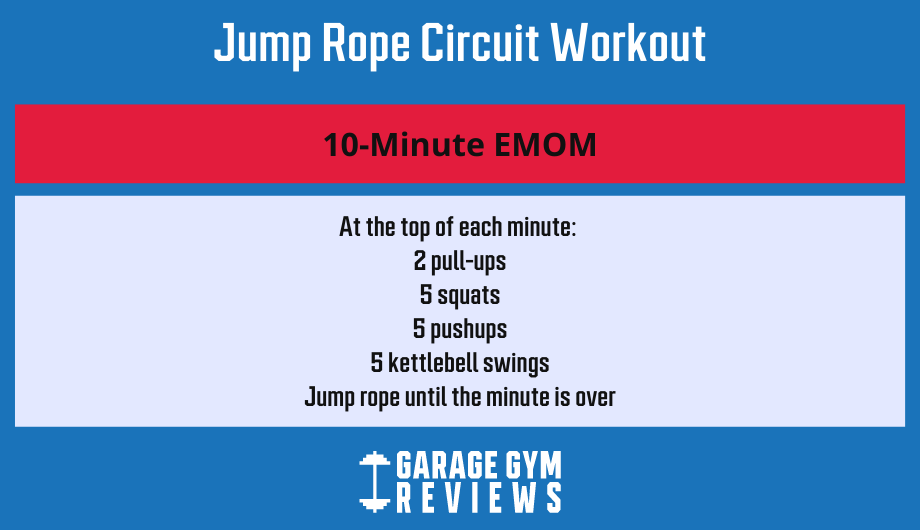
EMOM 10
2 pull-ups
5 squats
5 pushups
5 kettlebell swings
Jump rope until the minute is over
How to Do It:
- Start a running clock.
- At the top of each minute, perform the entire circuit, finishing with jump rope until the minute is over
The goal is to have 15 to 20 seconds of jump rope each round. If you need to make the workout easier, reduce the number of reps. If you want to make it harder, increase the number of reps.
Benefits of Jumping Rope
There are many reasons you might take up jumping rope, from getting in a great high-intensity interval training workout to using it as a warmup:
Fantastic Warmup
Jumping rope gets the blood flowing and activates a lot of your major muscle groups. My two most-used warmups incorporate the jump rope. You can skip rope for 2 to 10 minutes, or simply incorporate the movement into your regular workout routine by adding in a few rounds of 30 to 60 skips.
Increased Athleticism
There is a reason boxers use the jump rope so much. Coordination between your upper body and lower body is necessary for jumping rope. Another word for “coordination while moving through space” is “athleticism.” It’s not going to make you Antonio Brown, but increased foot speed and proprioception (your awareness of where your body is in space and how it moves through that space) are gifts that continue to give through all physical activity.
Portability
No piece of equipment is more portable than a jump rope, except perhaps a resistance band. Rather than spending time during a one-hour lunch break driving to the gym and back, a jump rope and a parking lot allow for superior time management.
Efficient HIIT Exercise
According to data from Harvard Health, 30 minutes of jumping rope can burn between 230 to 500 calories, depending on your size and intensity. That’s a lot of bang for your buck for an exercise that needs just a rope. When it comes to high-intensity interval training, jumping rope will definitely get your heart rate up, burn calories, and improve your aerobic capacity.
RELATED: Benefits of Jumping Rope
FAQs About Jumping Rope
How long should I jump rope as a beginner?
Listen to your body and work toward your goals. Taking just 15 minutes a day may be enough to get good practice in without getting frustrated. As with any new activity, it is better to wade into a new stimulus than jump into the deep end. Setting attainable goals allows you to look forward to the next workout knowing you are improving. Having a solid program in place is essential. It’s always more fun to make measurable progress than it is to hit a wall or burn out.
Is 10 minutes of jumping rope enough?
The first question we have to ask is, “Enough for what?” Ten minutes of jumping rope is an excellent way to warm up your muscles and mind before a strenuous workout. If your aerobic ability isn’t at a level where 10 minutes of jumping rope is comfortable, consider shorter rounds of jumping with more rest periods.
If weight loss is the goal, Harvard Health data suggests that you will burn more calories jumping rope in the same time spent jogging or walking. Does a 30-minute walk provide enough caloric expenditure for you to reach your goals? Be intentional with your choice of activity and level of commitment. A personal trainer may be able to assist you in this process.
How do you size a jump rope?
The simplest thing to do is to consult a chart and choose the right jump rope length for your height. If you buy a jump rope that needs to be cut down to the correct size at home, take certified personal trainer Amanda Capritto’s advice: “To size your rope, stand with both feet on the rope and pull the rope taut. The handles, pointed upward, should fall between your collarbone and chin.” And for the actual process of cutting: “Make sure you have a good pair of wire cutters on hand, as many wire ropes can’t be cut with regular scissors.”
Further reading

Finding the best pre-workout for men among hundreds of products on the market wasn’t easy, but we did it. Check out our top picks. Read more

Our Reebok Nano Gym Shoes review features insight from a certified personal trainer who tested this versatile training shoe for lifting, cardio, and more. Read more

What is whey protein? Whey protein is a widely consumed nutritional supplement thought to enhance strength and muscle mass when combined with heavy lifting. Read more

Check out our NordicTrack Commercial R35 review to see if this recumbent bike is right for you. Read more

